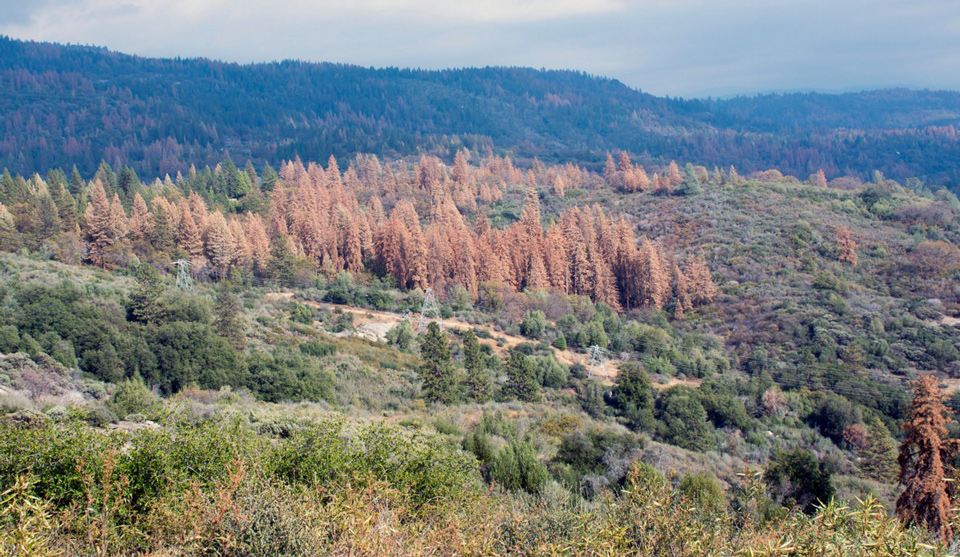
Tree Mortality in California
Photo Credit: CAL FIRE
July 6, 2016 - By Kate Campbell - From state highways, foothill campgrounds and aerial surveys, it's easy to see the catastrophic tree die-off in California forests. What isn't as easily grasped is the scale of rapidly expanding tree mortality in the state's 40 million acres of forestland—and what to do about it.
The U.S. Forest Service said in June that its survey showed more than 66 million trees, mostly pine species, have died in the southern Sierra Nevada alone, and more are dying. Forestry experts say the scale of the die-off is beyond anything ever observed. They attribute the tree mortality to four years of drought, bark beetle infestations, climate change and mismanagement.
"I'm afraid people are going to think the catastrophe we're seeing in our forests today is just a natural cycle of drought and insect infestations, but there's a lot more to this story," Tuolumne County rancher Shaun Crook said. "What we have now is the culmination of 40 years of forest mismanagement that has led to these devastating conditions."
Crook said if Sierra forests had been harvested in recent decades using sustainable-yield practices, they would not be as overgrown and would not be as vulnerable to drought, infestation and disease, which occur naturally.
Erin Huston, federal policy consultant for the California Farm Bureau Federation, said forests need to be actively managed for the multiple uses they were intended to serve.
"This includes active management at a pace and scale that keeps our forests resilient," Huston said. "We'd like to see federal legislation that improves the climate for fuels reduction, for salvage logging and grazing after fires, and for forest watershed management."
Farm Bureau and other organizations also support legislation to develop a wildfire emergency funding process that provides more reliable funding without harming land management and fire-reduction activities. U.S. Agriculture Secretary Tom Vilsack said unless Congress acts rapidly to address how the Forest Service pays for firefighting, the agency will not have the resources necessary to fight wildfires, address the tree die-off and restore forests.
Historically, what forest managers have done to protect forest stands against drought and beetle infestations is to reduce the number of large trees and thin the stands, said Bill Stewart, co-director of the Center for Forestry at the University of California, Berkeley.
He talks about maintaining "thrifty" forests that are leaner and cleaner, that use far less water than current, overstocked stands and, through natural and vigorous growth, store more carbon dioxide emissions, which improves air quality.
At the same time, he said, healthy Sierra forests can continue to provide improved grazing, recreation and business opportunities.
"Unfortunately, 30 to 40 years ago the public said, 'Keep all the trees in the forest.' But now we're finding out there just isn't enough water in California to keep all those trees alive," Stewart said.
Crook noted that when timber was thinned in the past, homeowners and small timberland owners also had markets at nearby sawmills and biomass plants, where they could salvage some of the wood and recoup part of the removal costs.
"Now, there are no wood-processing facilities—or the few that remain are maxed out—again because of (forest) mismanagement," he said. "The only way to get the processing infrastructure back is to provide a guaranteed supply of timber from federal lands, so it can be turned into useful consumer products."
Although the southern Sierra has been hit the hardest by the current tree die-off, Brittany Covich of the Sierra Nevada Conservancy said the underlying conditions leading to the tree mortality exist throughout the Sierra.
"We rely on healthy Sierra forests to filter and store the water runoff that feeds the State Water Project and the Central Valley Project, which supply irrigation water for hundreds of thousands of acres of farmland," Covich said. "The forests of the Sierra Nevada region play a critical role in maintaining a reliable water source for California, but current conditions in the Sierra place that role at risk."
CFBF Director of Water Resources Danny Merkley said agencies need the resources to thin forests to maintain forest health, noting that only about 3 percent of new forest growth is being removed each year—leaving 97 percent of new growth to compound overstocked conditions.
On the longer term, he said, there's a need for additional public awareness about what's needed to maintain healthy, sustainable forests.
"Forests are a major part of our watersheds and directly impact our water supply," Merkley said. "We need to rethink how we manage our forests, in all their complexity, for resilient forests now and into the future."
Last fall, Gov. Brown declared a state of emergency because of the tree die-off and formed a multidisciplinary tree mortality task force to help with safe removal of dead and dying trees. The task force includes more than 80 local, state and federal agencies, as well as utilities and other stakeholders, including groups representing ranching and grazing interests.
The state has purchased 10 air-curtain burners—20-foot long, metal blast-sheet containers that can incinerate up to eight trees an hour, with low air emissions. The purchase was part of a $5 million investment in equipment to address the tree-mortality epidemic.
The trees pose serious public safety risks beyond catastrophic wildfires. Vilsack said the Forest Service is reprioritizing $32 million in California to remove dead trees along roads, trails and recreation sites, where falling timber is likely to threaten people, powerlines and structures.
Forest Service scientists said they expect to see continued elevated levels of tree mortality through 2016 in dense forest stands with root diseases and high levels of bark beetle activity.
Additional surveys across California forestland will be conducted throughout the summer and fall, they said.
(Kate Campbell is an assistant editor of Ag Alert. She may be contacted at kcampbell@cfbf.com.)
Reprinted with permission: California Farm Bureau Federation









